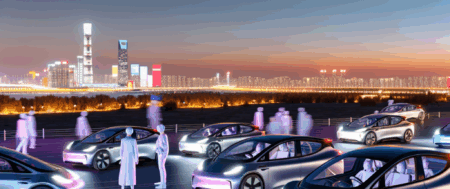TL;DR: Success in China, the world’s top and largest automotive market, demands a keen understanding of the regulatory landscape, alignment with consumer preferences, and adaptation to technological advancements. The shift towards Electric Vehicles (EVs) and New Energy Vehicles (NEVs), driven by urbanization, a growing economy, and environmental concerns, is creating substantial opportunities. For foreign automakers and domestic car brands, forming strategic partnerships through joint ventures and leveraging government incentives are crucial to navigate market competition and regulatory challenges effectively. Despite the hurdles of an evolving regulatory framework and the need for constant innovation, focusing on EVs and NEVs can unlock significant rewards in this dynamic industry landscape.
In the heart of the global automotive industry’s transformation, China emerges as the undisputed leader, holding the title of the Largest Automotive Market in the world. This powerhouse not only leads in production and sales but is also at the forefront of embracing Electric Vehicles (EVs) and New Energy Vehicles (NEVs), driven by a combination of government incentives, environmental concerns, and a rapidly growing economy. With its burgeoning middle class and accelerated urbanization, China’s automotive market offers a unique blend of opportunities and challenges for both domestic car brands and foreign automakers. These international entities often enter strategic partnerships and form Joint Ventures with local Chinese companies, a crucial step to navigate the intricate regulatory landscape and tap into the extensive consumer base.
As the market evolves, fueled by consumer preferences, technological advancements, and global economic trends, understanding its dynamics becomes essential. This article delves into the strategies and challenges faced by players within China’s Dynamic Industry Landscape, shedding light on the competitive environment, the importance of aligning with government policies, and the crucial role of innovation in staying ahead. From exploring the significance of EVs and NEVs in the context of environmental sustainability to decoding the complexities of market competition and strategic partnerships, we offer an insightful exploration of what it takes to succeed in the world’s top automotive market. Join us as we navigate through the multifaceted and ever-changing terrain of China’s automotive industry, where understanding the balance between adhering to the regulatory landscape and meeting consumer demands is key to capturing the vast potential of this lucrative market.
1. “Navigating the Largest Automotive Market: Strategies and Challenges in China’s Dynamic Industry Landscape”

Navigating the Largest Automotive Market: Strategies and Challenges in China’s Dynamic Industry Landscape
As the largest automotive market in the world, China presents a fertile ground for both domestic car brands and foreign automakers. However, succeeding in this dynamic and competitive landscape requires a nuanced understanding of various factors, from government incentives to consumer preferences and the regulatory landscape. The country’s growing economy, rapid urbanization, and the burgeoning middle class have fueled a surge in demand for vehicles, notably Electric Vehicles (EVs) and New Energy Vehicles (NEVs), driven by environmental concerns and strong government backing.
Foreign automakers looking to tap into this vast market often engage in joint ventures with local Chinese companies. This strategic partnership is not just a choice but a necessity, navigating the complex regulatory framework and gaining access to the consumer base. These collaborations can offer a strategic advantage, providing foreign brands with essential insights into consumer preferences, market trends, and the regulatory environment that defines the Chinese automotive sector.
The emphasis on EVs and NEVs highlights the market’s unique blend of technological advancements and environmental stewardship, with government incentives further propelling this segment. This push towards green vehicles has created a sub-niche within the market that brands can capitalize on, but it also requires them to stay abreast of technological advancements and adapt their offerings accordingly.
Market competition in China is fierce, with domestic and international players vying for consumers’ attention. Understanding consumer preferences is crucial, as the Chinese market exhibits unique trends and demands, from the desire for cutting-edge technology to specific vehicle functionalities tailored to the urbanized lifestyle. Brands that succeed here are those that can align their product development and marketing strategies with these localized needs, often through detailed market research and consumer insights.
However, the challenges in this market are as vast as the opportunities. The regulatory landscape in China is complex and ever-evolving, posing a significant hurdle for foreign automakers unfamiliar with the local rules and norms. Moreover, the competitive nature of the market means that companies must continually innovate and adapt to stay ahead. This requires substantial investment in research and development, as well as a flexible business model that can quickly respond to market shifts and policy changes.
In conclusion, navigating the largest automotive market in the world requires a strategic and informed approach. Success hinges on understanding and adapting to the regulatory landscape, consumer preferences, and technological advancements. Strategic partnerships, such as joint ventures, play a pivotal role in accessing the market and leveraging local expertise. At the same time, a focus on EVs and NEVs aligns with government incentives and environmental concerns, presenting significant growth opportunities. Despite the challenges, the rewards of mastering the Chinese automotive market can be substantial, offering access to a vast and still-expanding consumer base in one of the world’s most dynamic economic landscapes.
In conclusion, China’s position as the largest automotive market in the world is a testament to its rapidly growing economy, expanding urbanization, and the evolving preferences of its burgeoning middle class. The country’s acute focus on electric vehicles (EVs) and new energy vehicles (NEVs), driven by government incentives and growing environmental concerns, underscores a future-oriented approach within the automotive industry. Both foreign automakers and domestic car brands are navigating this dynamic and competitive landscape through strategic partnerships and joint ventures, aiming to leverage the vast opportunities presented by this market while adhering to its complex regulatory landscape.
The success in China’s automotive sector requires a nuanced understanding of consumer preferences, technological advancements, and the intricate balance of global economic trends with local market dynamics. As the industry moves forward, the emphasis on EVs and NEVs, combined with China’s role as a key player in the global automotive industry, suggests a continuing shift towards sustainability and innovation. For companies looking to thrive in this environment, the ability to adapt to the rapid changes, engage in strategic partnerships, and navigate the regulatory landscape will be paramount. The future of the automotive industry in China promises growth and challenges alike, driven by market competition, government policies, and the ever-evolving demands of the Chinese consumer.






